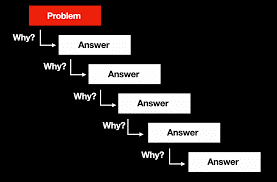DRILLING DOWN WITH QUESTIONS
TO THE ROOT CAUSE OF THE PROBLEM

In Parts 1 and 2 of this series we showed how high-quality questions can open doors that would otherwise remain closed, challenge mind-sets, and get you out of ruts. We also stated that while the questions we ask others are helpful, often the questions we ask ourselves are even more valuable as they are likely to impact us the most. And they could be even more impactful if we muster the courage to ask ourselves those high-quality questions that strike at the root of the problem.

But how do we learn how to formulate and ask those high-quality questions? Or how do we know if the questions we ask will lead to the root of the problems?
Well, there are many ways to learn how to formulate high-quality questions as a method of inquiry, such as in coaching training.
But I want to introduce to you the 5-Whys Questioning Technique. Sakichi Toyoda, Japanese inventor and industrialist, is credited with its development. It is an iterative, interrogative technique for investigating the cause-and-effect relationship between a problem and its solution.
The technique involves asking Why 5 successive times – each answer forming the basis for the subsequent question in order to arrive at the root of the problem and hence, its solution. As simple as it sounds, Taiichi Ohno, the architect of the Toyota Production System, describes it as the basis of the Toyota’s scientific approach. It was a critical component of problem-solving training, delivered as part of the induction process into the Toyota Production System.
It has now spread beyond Toyota to include Lean Manufacturing, Six Sigma process improvement technique, among others. And I believe that we can apply the technique to improve our lives. Asking ourselves quality questions and providing honest answers is an immensely powerful technique for self-improvement. Quality questions = quality life.
This techniques assumes, and quite rightly so, thatevery problem has a cause behind it. However, a superficial analysis will only depict symptoms. A persistent inquiry is therefore required to find the real cause (the root cause) of the problem so that a lasting solution can be found to prevent reoccurrence. The 5-Whys questioning technique does just that.
For example, let us assume that we want to find out why a man has been laid off by his employer by using the 5-Whys method. We ask the following questions:
Q1: We: Why were you laid off by your employer?
A1: The Man: I was laid off because they employed new people and carried out staff audit.
Q2: We: Why did they lay you off when they are even recruiting new people and you’ve been with them for a long time.
A2: The Man: They laid me off after staff audit.
Q3: We: Why? What did the staff audit show?
A3: The Man: The audit showed that the new people are more qualified than me.
Q4: We: Why are they more qualified that you when you’ve been working there for many years and have a lot of experience?
A4: They have higher academic and professional qualifications whereas I only have a diploma.
We have uncovered the root cause of the problem: he lost his job because of inadequate academic and professional qualifications. In other words, he lost his job because of lack of personal development.
With that, we can then device an appropriate and effective solution.
By the way, this example is from a real-life experience of someone I read about in the newspaper today. Don’t let that happen to you. Join our training courses.
That is how you can use the 5-Whys questioning technique to drill down to the root cause of problems, whatever it is.
Be blessed.


